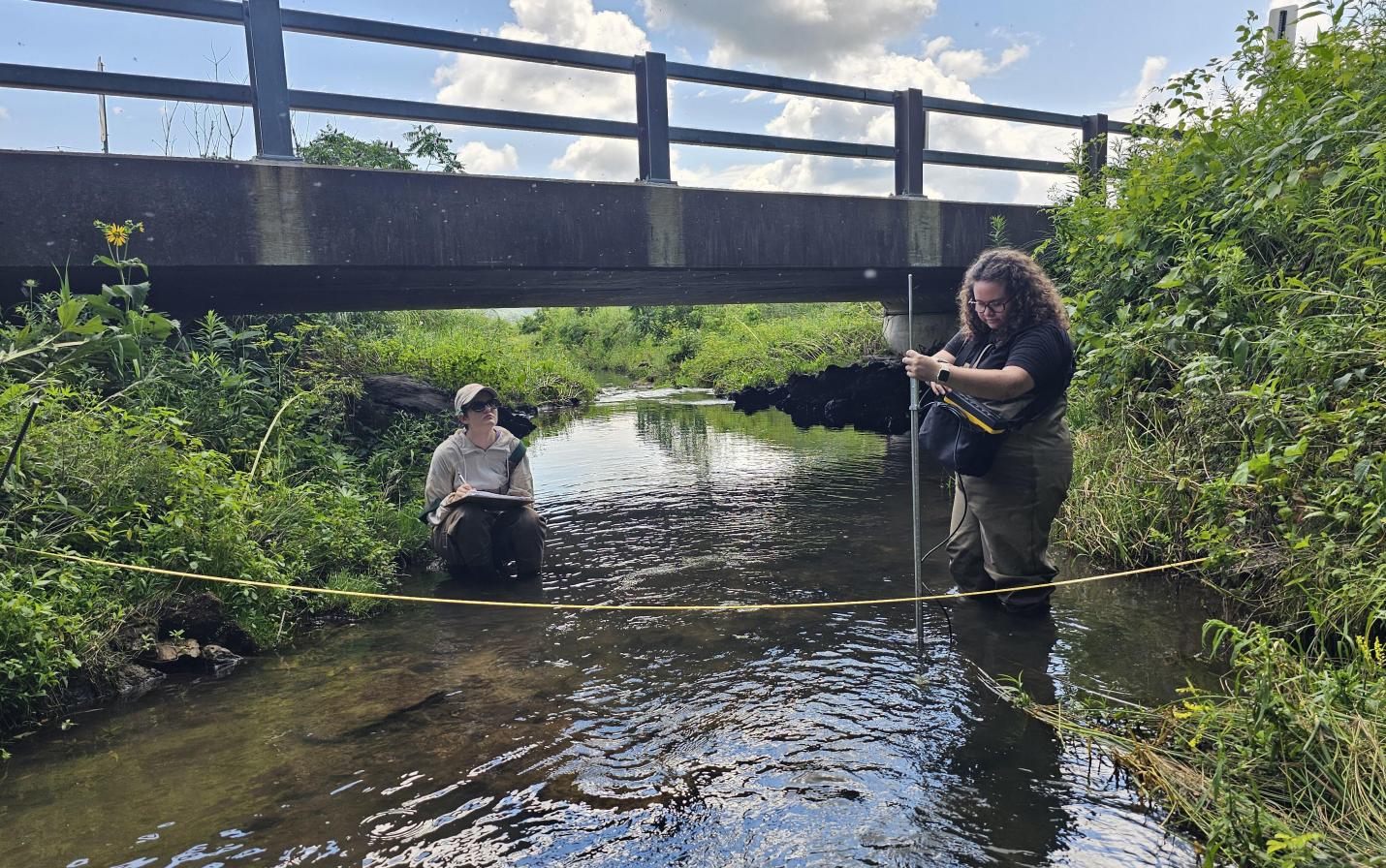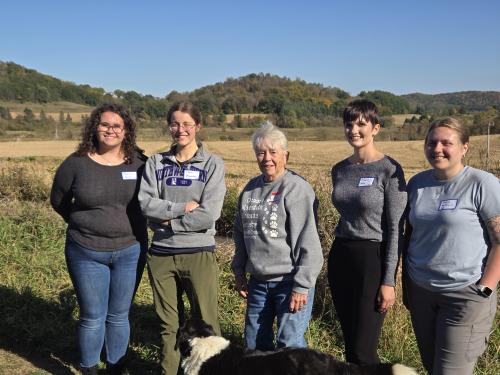
Ten students from the University of Wisconsin Nelson Institute for Environmental Studies Water Resources & Management program have embarked upon a research project within the Fancy Creek watershed in Richland County. One of the properties they are collecting data on was protected by Mississippi Valley Conservancy with a conservation easement with the owner, Marilyn Houck. Marilyn’s property includes a nearly mile-long stretch of Fancy Creek.
Back in the 1930’s, Fancy Creek meandered through wetlands, sedge meadows, pastures and agricultural fields before its confluence with the Upper Pine River, just north of Richland Center. The creek and wetlands supported a diverse population of wildlife and held onto vast amounts of water during wet seasons. This is how Marilyn Houck, current owner of a large section of the Fancy Creek watershed, imagines her mother-and-father-in-law would have seen it when they acquired the land .
In 1947, Fancy Creek was ditched and straightened cutting off the meandering channel and directing flows down a habitat-deprived chute. This change disconnected the creek from the surrounding wetlands and floodplain. In a nationwide trend, many wetlands have been reduced or lost due to development and land management practices that did not fully value their ecological role. The ditching of Fancy Creek has also likely contributed to some of the 5, 10 and 100-year floods that have caused damage in the City of Richland Center. By preventing the wetlands from absorbing floodwaters, the ditch channel has allowed water to shoot downstream like a firehose.
With knowledge of the property’s past and much hope for its future, Marilyn contacted several area conservation groups, to explore the potential for the creek to be restored to its historic meandering path. The scope of such a project would require partners, neighbors, and researchers to plan and implement a restoration solution. One of the immediate needs for any such project is to gather data, and the student research team was up to the challenge.

The data collected by the students included measuring the depth of the water table the temperature, water conductivity, quality, and chemistry. One feature of the research project was installation of groundwater wells in key locations to measure the water table throughout the year. Some of these wells allow remote monitoring throughout the year and may provide valuable comparative data that shows groundwater levels in changing seasonal conditions. According to Hanna Kollbaum, who was responsible for the implementation of the groundwater and surface water monitoring efforts, the most challenging part of the project was physically getting into the wetland, especially when carrying equipment. “It was a difficult walk and we had to fight the uneven ground, tall vegetation, and the heat,” she said. Measurements were taken for ten weeks at eleven different sites throughout the watershed. They measured groundwater flow with seepage meters to determine if water is flowing up from the groundwater into the creek and wetlands or vice versa. Phosphorous and nitrogen measurements were also taken. Remote monitoring was measured with a Mayfly data logger that was powered by a small solar panel, taking measurements every 15 minutes. This data was especially useful to show the impact of heavy rains in June.
For the Conservancy and for Marilyn Houck, the research has provided valuable baseline data to help guide future restoration work. It has also added new species to the property records maintained by the Conservancy. “It has been a dream of mine for these wetlands to provide a living laboratory for the students”, said Marilyn, “and I’ve been so impressed by the thoughtful and strenuous work they have invested in this project.”
The students also evaluated the health of the habitat within and surrounding Fancy Creek by conducting macroinvertebrate surveys, vegetation surveys, and fishery surveys. The students sampled two segments of Fancy Creek on Marilyn's property. For fish, they found blacknose dace, bluegill, brook stickleback, brown trout, creek chub, gizzard shad, johnny darter, white sucker, and mottled sculpin. For macroinvertebrates, they found a variety of different organisms, such as mayflies, caddisflies, scuds, planaria, riffle beetles, water mites, midges, and aquatic worms. “Mayflies and caddisflies in particular are known for being sensitive to pollution, so it was encouraging and somewhat surprising that we found them in the stream,” said Meredith Laidly, who was responsible for leading those surveys.
Many members of the student cohort have stated that the project is helping to shape their future career paths. “This project has done so much for my future career search. Not only have I learned new technical skills in water quality sampling and wetland vegetation work, as well as exposure to biological sampling, I've also gotten firsthand experience in project development and management,” said Madilyn Marti, who was responsible for leading the wetland vegetation surveys.
“The quantity of data collected is impressive, each person involved is gaining incredible hands-on experience learning about watershed ecology. Mississippi Valley Conservancy’s conservation easement ensures that Marilyn’s wetlands and stretch of Fancy Creek will continue to benefit area wildlife, in perpetuity. When students collect data here, they have the assurance that future students can come back to re-sample in 10 years or 100 years without the threat of habitat loss from land use changes,” said Abbie Church, Conservation Director at the Conservancy. “We are thankful for Marilyn’s conservation efforts and gratified to learn how the project is further inspiring a new generation of conservationists in their career pursuits. We look forward to learning more of the project findings in the final project report next spring.”
Top photo: Madilyn Marti and Alayne Kulp collect water quality data at an upper reach of Fancy Creek. Photo Credit: Norman Muhammad.